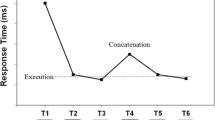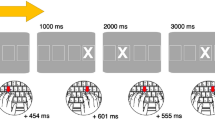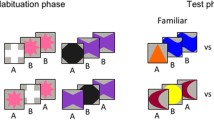Abstract
Perception, production, and understanding of sequences is fundamental to human behavior and depends, in large part, on the ability to detect serial order. Despite the importance of this issue across many domains of human functioning, the development of serial order skills has been neglected in developmental studies. The current article reviews evidence that the basic temporal and spatiotemporal skills that are necessary for the development of serial order skills emerge early in human development. The article then presents recent evidence from the author’s laboratory showing that serial order perceptual skills emerge at the same time and improve rapidly. Consistent with a multisensory redundancy view of perception, when serial order perceptual abilities first emerge in infancy, they depend critically on the redundant specification of sequences in both the auditory and visual modalities. The findings suggest that infants’ ability to perceive the surface serial order characteristics of sequentially organized events provides the necessary antecedents to the development of more complex serial order skills that ultimately enable us to extract meanings from sequentially organized events and perform complex sequential actions.







Similar content being viewed by others
References
Aslin RN, Saffran JR, Newport EL (1999) Statistical learning in linguistic and nonlinguistic domains. In: MacWhinney B (ed) The emergence of language. Lawrence Erlbaum Associates, Inc., Mahwah
Bahrick LE, Lickliter R (2000) Intersensory redundancy guides attentional selectivity and perceptual learning in infancy. Dev Psychol 36:190–201
Baldwin DA, Baird JA (2001) Discerning intentions in dynamic human action. Trends C SC 5:171–178
Bauer PJ, Wiebe SA, Waters JM, Bangston SK (2001) Reexposure breeds recall: effects of experience on 9-month-olds’ ordered recall. J Exp Child Psychol 80:174–200
Brooks PR, Berg WK (1979) Do 16-week-old infants anticipate stimulus offset? Dev Psychobiol 12:329–334
Canfield RL, Haith MM (1991) Young infants’ visual expectations for symmetric and asymmetric stimulus sequences. Dev Psychol 27:198–208
Carver LJ, Bauer PJ (1999) When the event is more than the sum of its parts: 9-month-olds’ long-term ordered recall. Memory 7:147–174
Carver LJ, Bauer PJ (2001) The dawning of a past: the emergence of long-term explicit memory in infancy. J Exp Psychol Gen 130:726–745
Chang HW, Trehub SE (1977) Auditory processing of relational information by young infants. J Exp Child Psychol 24:324-331
Chen S, Swartz KB, Terrace HS (1997) Knowledge of the ordinal position of list items in rhesus monkeys. Psychol Sci 8:80–86
Clifton RK (1974) Heart rate conditioning in the newborn infant. J Exp Child Psychol 18:9–21
Colombo J, Richman WA (2002) Infant timekeeping: attention and temporal estimation in 4-month-olds. Psychol Sci 13:475–479
Conway CM, Christiansen MH (2001) Sequential learning in non-human primates. Trends C SC 5:539–546
Demany L, McKenzie B, Vurpillot E (1977) Rhythm perception in early infancy. Nature 266:718–719
Donohue RL, Berg WK (1991) Infant heart-rate responses to temporally predictable and unpredictable events. Dev Psychol 27:59–66
Dougherty TM, Haith MM (1997) Infant expectations and reaction time as predictors of childhood speed of processing and IQ. Dev Psychol 33:146–155
Ebenholtz SM (1963) Serial learning: position learning and sequential associations. J Exp Psychol 66:353–362
Fraisse P (1982) Rhythm and tempo. In: Deutsch D (ed) The psychology of music. Academic, New York, pp 149–180
Gibson EJ (1969) Principles of perceptual learning and development. Appleton, New York
Gulya M, Rovee-Collier C, Galluccio L, Wilk A (1998) Memory processing of a serial list by young infants. Psychol Sci 9:303–307
Keele SW, Ivry R, Mayr U, Hazeltine E, Heuer H (2003) The cognitive and neural architecture of sequence representation. Psychol Rev 110:316–339
Kellman PJ, Arterberry ME (1998) The cradle of knowledge: development of perception in infancy. MIT Press, Cambridge
Lashley KS (1951) The problem of serial order in behavior. In: Jeffress LA (ed) Cerebral mechanisms in behavior: The Hixon symposium. Wiley, New York, pp 123–147
Lester BM, Hoffman J, Brazelton TB (1985) The rhythmic structure of mother–infant interaction in term and preterm infants. Child Dev 56:15–27
Lewkowicz DJ (1985) Bisensory response to temporal frequency in 4-month-old infants. Dev Psychol 21:306–317
Lewkowicz DJ (1986) Developmental changes in infants’ bisensory response to synchronous durations. Infant Behav 9:335–353
Lewkowicz DJ (1989) The role of temporal factors in infant behavior and development. In: Levin I, Zakay D (eds) Time and human cognition: a life-span perspective. North-Holland, Amsterdam, pp 9–62
Lewkowicz DJ (1992a) Infants’ response to temporally based intersensory equivalence: the effect of synchronous sounds on visual preferences for moving stimuli. Infant Behav 15:297–324
Lewkowicz DJ (1992b) Infants’ responsiveness to the auditory and visual attributes of a sounding/moving stimulus. Percept Psychophys 52:519–528
Lewkowicz DJ (1996) Perception of auditory–visual temporal synchrony in human infants. J Exp Psychol P 22:1094–1106
Lewkowicz DJ (2000a) The development of intersensory temporal perception: an epigenetic systems/limitations view. Psychol Bull 126:281–308
Lewkowicz DJ (2000b) Infants’ perception of the audible, visible and bimodal attributes of multimodal syllables. Child Dev 71:1241–1257
Lewkowicz DJ (2002) Heterogeneity and heterochrony in the development of intersensory perception. Cogn Brain Res 14:41–63
Lewkowicz DJ (2003) Learning and discrimination of audiovisual events in human infants: The hierarchical relation between intersensory temporal synchrony and rhythmic pattern cues. Dev Psychol 39:795–804
Lewkowicz DJ (2004) Perception of serial order in infants. Dev Sci 7:175–184
Lewkowicz DJ, Kraebel K (2004) The value of multimodal redundancy in the development of intersensory perception. In: Calvert G, Spence C, Stein B (eds) Handbook of multisensory processing. MIT Press, Cambridge
Mandel DR, Nelson DG, Jusczyk PW (1996) Infants remember the order of words in a spoken sentence. Cogn Dev 11:181–196
Martin JG (1972) Rhythmic (hierarchical) versus serial structure in speech and other behavior. Psychol Rev 79:487–509
Mendelson MJ (1986) Perception of the temporal pattern of motion in infancy. Infant Behav 9:231–243
Merriman J, Rovee-Collier C, Wilk A (1997) Exemplar spacing and infants’ memory for category information. Infant Behav 20:219–232
Morrongiello BA (1984) Auditory temporal pattern perception in 6- and 12-month-old infants. Dev Psychol 20:441–448
Orlov T, Yakovlev V, Hochstein S, Zohary E (2000) Macaque monkeys categorize images by their ordinal number. Nature 404:77–80
Piaget J (1952) The origins of intelligence in children. International Universities Press, New York
Pickens J, Bahrick LE (1995) Infants’ discrimination of bimodal events on the basis of rhythm and tempo. Br J Dev Psychol 13:223–236
Pickens J, Bahrick LE (1997) Do infants perceive invariant tempo and rhythm in auditory–visual events? Infant Behav 20:349–357
Saffran JR, Aslin RN, Newport EL (1996) Statistical learning by 8-month-old infants. Science 274:1926–1928
Saffran JR, Johnson EK, Aslin RN, Newport EL (1999) Statistical learning of tone sequences by human infants and adults. Cognition 70:27–52
Scheier C, Lewkowicz DJ, Shimojo S (2003) Sound induces perceptual reorganization of an ambiguous motion display in human infants. Dev Sci 6:233–244
Sekuler R, Sekuler AB, Lau R (1997) Sound alters visual motion perception. Nature 385:308
Stern DN, Beebe B, Jaffe J, Bennet SL (1977) The infant’s stimulus world during social interactions: a study of caregiver behaviors with particular reference to repetition and timing. In: Shaffer HR (ed) Studies in mother–infant interaction. Academic, London
Terrace HS (1993) The phylogeny and ontogeny of serial memory: list learning by pigeons and monkeys. Psychol Sci 4:162–169
Terrace H (2001) Chunking and serially organized behavior in pigeons, monkeys and humans. In: Cook RG (ed) Avian visual cognition. www.pigeon.psy.tufts.edu/avc/terrace/
Thorpe LA, Trehub SE (1989) Duration illusion and auditory grouping in infancy. Dev Psychol 25:122–127
Thorpe LA, Trehub SE, Morrongiello BA, Bull D (1988) Perceptual grouping by infants and preschool children. Dev Psychol 24:484–491
Trehub SE, Schneider BA, Henderson JL (1995) Gap detection in infants, children, and adults. J Acoust Soc Am 98:2532–2541
Wenner JA, Bauer PJ (1999) Bringing order to the arbitrary: one- to two-year olds’ recall of event sequences. Infant Behav 22:585–590
Werner H (1973) Comparative psychology of mental development. International Universities Press, New York
Werner LA, Marean GC, Halpin CF, Spetner NB, Gillenwater JM (1992) Infant auditory temporal acuity: gap detection. Child Dev 63:260–272
Zacks JM, Tversky B (2001) Event structure in perception and conception. Psychol Bull 127:3–21
Acknowledgements
I express my deep gratitude to Marcia Dabbene for her assistance with the empirical work reviewed here. The research presented here was supported in part by the New York State Office of Mental Retardation and Developmental Disabilities and by NICHD grant R01 HD35849.
Author information
Authors and Affiliations
Corresponding author
Additional information
Edited by: Marie-Hélène Giard and Mark Wallace
Rights and permissions
About this article
Cite this article
Lewkowicz, D.J. Serial order processing in human infants and the role of multisensory redundancy. Cogn Process 5, 113–122 (2004). https://doi.org/10.1007/s10339-004-0015-1
Received:
Revised:
Accepted:
Published:
Issue Date:
DOI: https://doi.org/10.1007/s10339-004-0015-1




